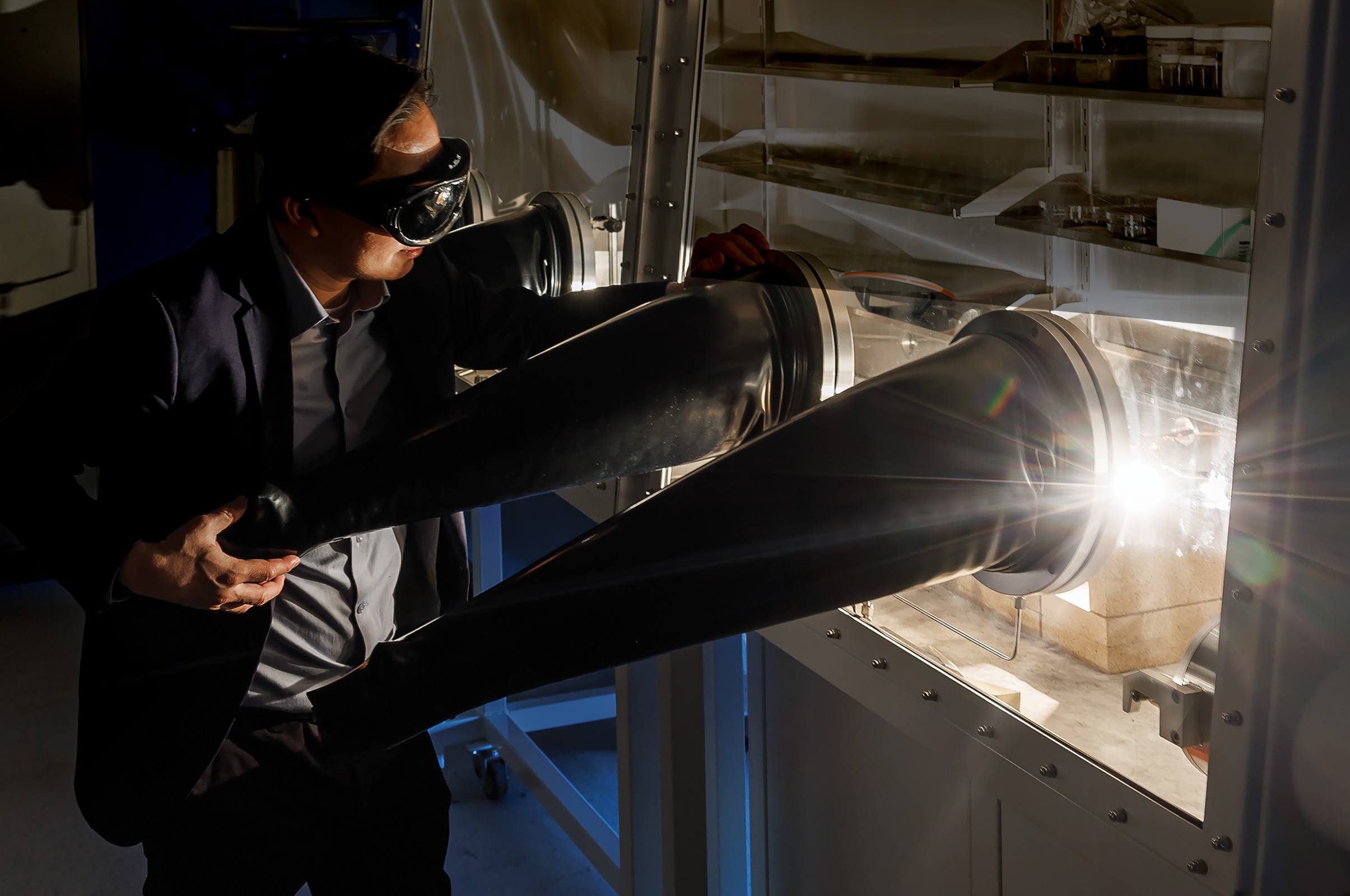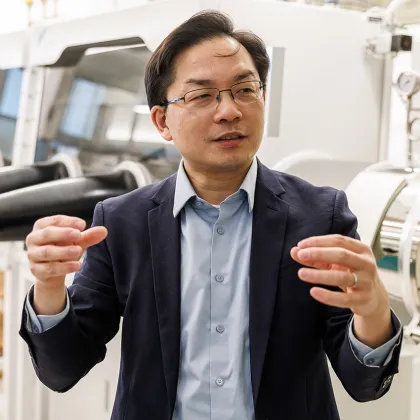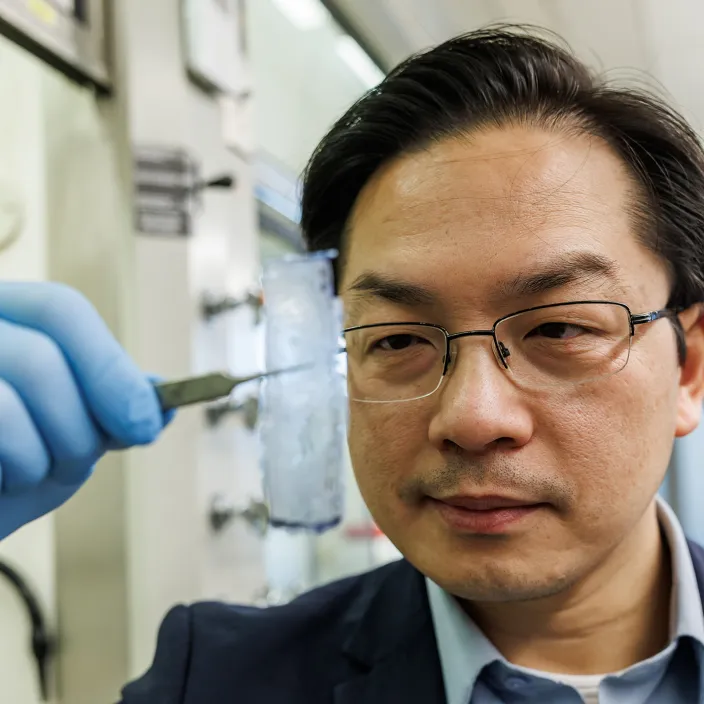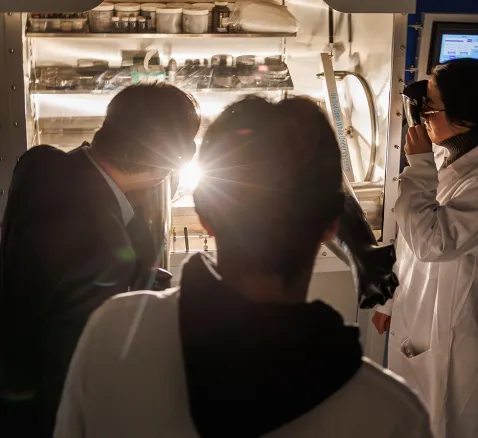Igniting innovation
This story originally appeared in Yale Engineering magazine.
To walk through Liangbing Hu’s lab is to find mind-boggling inventions everywhere you turn: Self-cooling paint, protective dental coating, transparent wood, super-strong wood, bouncy wood. There’s a furnace that’s hotter than the sun and batteries made from crab shells. It’s hard to keep up. It’s all the more impressive considering that Hu had just opened his lab a few weeks earlier, having recently come to Yale from the University of Maryland.
Read more • Approximately 7 minutesThere are a few themes that run through Hu’s work. One is leveraging nature for energy, clean water, flexible electronics and other emerging technologies. Making use of physics, chemistry, electrical engineering, and materials science, his lab seeks to understand and explore the characteristics of emerging nanomaterials and using nanomanufacturing to develop new materials with new applications. There’s an emphasis on environmental sustainability in his work. That’s one of the reasons much of his research focuses on wood fibers and chitosan, the material that makes up the exoskeletons of shellfish — they’re two of the most abundant materials on Earth, he points out. But abundance alone isn’t enough.
Hotter than the sun

“The world has to make certain changes, but people won’t use these materials just because they’re renewable — they have to be better,” Hu said. “So that’s our job. How can we make them better?”

“I heat different things and I cook them in different ways so that we can get some useful applications. When I cook the materials, I always think about how this thing can be manufactured at scale. You can almost consider me a chef!
Liangbing Hu
Professor of Electrical & Computer Engineering and Materials Science
The surface of the sun is about 6,000 degrees Celsius. Hot enough for ya? Not for Hu. In his lab, he’s created a plasma-producing device that reaches an incredible 8,000 degrees. The device produces a lightning bolt of plasma — often referred to as the “fourth state of matter” — that’s so bright you can’t look at it without eye protection.
All of which would be amazing in itself. But Hu has also designed the device to be stable and uniform, and sustainable for up to 20 minutes.
The key is in the electrodes, made of two dense clusters of carbon fibers, between which the plasma bolt flows. Each fiber serves as a tip for ejecting electrons easily which then ionize the gas. With less than 50 volts, the argon gas in the furnace converts to high-temperature plasma. As a result, the researchers can harness this hotter-than-the-sun furnace toward real-world applications, including testing materials, manufacturing new ones, and 3D printing.
“With this kind of so-called extreme heating, you can program the heating pattern,” said Hu, the Carol and Douglas Melamed Professor of Electrical & Computer Engineering and Materials Science. “You turn it on and off, do the things you really want so you can control the reaction pathway, get the materials people could not get before.”
It creates the kind of extreme conditions that are required to test jet engine turbine blades. Perhaps most important is that the plasma system can be easily recreated, eliminating the need for hard-to-access specialist labs to create the conditions necessary to test new materials.
“Something I’m very excited about is using extreme processing for manufacturing,” he said. “I heat different things and I cook them in different ways so that we can get some useful applications. When I cook the materials, I always think about how this thing can be manufactured at scale. You can almost consider me a chef!”
Transforming wood
Hu has dramatically transformed one of the oldest building materials in the world by making it nearly completely transparent. In his lab, Hu discovered that by removing part of a wood’s lignin (a polymer that gives a tree its color and some of its structure), he could make it partially transparent.
Besides being astounding, transparent wood can come in handy. For one thing, it’s three times stronger than Plexiglass. And it’s a better insulator.
So it’s no wonder that Hu is teaming up with colleagues at the Yale School of Architecture to see what kinds of uses they can find for this innovation.
Hu does much more with wood than making it see-through. He’s also created “super wood,” in which wood has been treated in a way that makes it 12 times stronger than natural wood. That makes it as strong as carbon-intensive steel, but a lot lighter. Again, that makes it a very valuable architectural material. Like the transparent wood, the process also involves the removal of the lignin. The wood is then tightly compressed under heat, which tightly packs the wood’s fibers together.
Not only could it replace certain metals for some applications, Hu’s innovations might also mean that balsa, pine and other soft woods that grow fast could be used instead of dense and slow-growing woods.
One shortcoming of natural wood is that it can’t be molded like plastic, concrete or metal. Hu’s got a fix for that also by finding a way to make wood bendable. In addition to removing the wood’s lignin, the process includes removing any water, and then reintroducing it to the wood. The result is a spongy, elastic material that can be used in electronics, batteries, and other applications. As a way to commercialize some of his wood innovations, Hu co-founded the company InventWood.

Powered by crab
A battery made from crab shells might sound unusual, but in Hu’s case, it makes sense. His mission is to use whatever materials are most abundant. Chitosan, the sugar that makes up the exoskeletons of crabs, lobsters, shrimp, and other shellfish, is one of the most abundant materials in the world. And in Maryland — Hu’s home before coming to Yale — crabs are everywhere.
Aqueous zinc batteries are one focus of this line of research. These inexpensive batteries hold great promise but can have limited lifespans due to the spiky zinc formations that form on the anodes.
With crab shells in hand, Hu and his research team got cracking on the problem. They designed and built an aqueous zinc battery using chitosan as an electrolyte, the part of the battery that transfers ions between the battery’s negative and positive terminals.
“We have engineered this crab shell material to be excellent ion conductors for lithium, for sodium, or for zinc,” Hu said.
The electrolytes in most commercially made batteries are often made of corrosive materials that can take hundreds or even thousands of years to break down. The biodegradable chitosan-based electrolyte, on the other hand, breaks down in a matter of months.
Not only would this technology make batteries more environmentally friendly, it would provide a use for the millions of tons of shells from crabs, lobsters, shrimp and other sea creatures that go to waste every year. Hu sees this all as a small part of a much bigger mission.
“We are facing this grand challenge, and researchers like us, we have this great opportunity in this renewable energy transition,” Hu said. “There’s a huge potential, and I think it’s going to happen.”
More Details
Published Date
Apr 9, 2025


